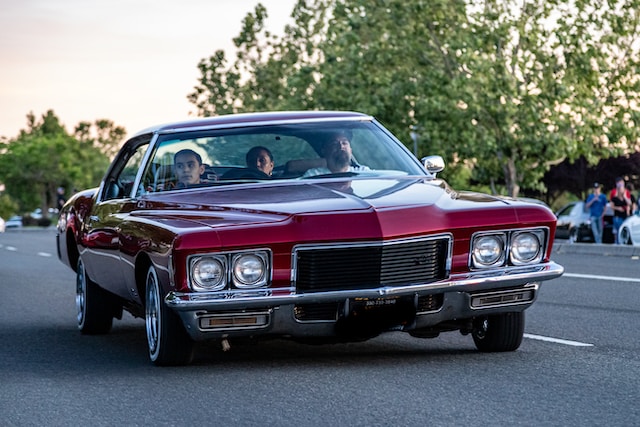Lowriders have been a part of Mexican American culture since 1940 and have become a worldwide phenomenon. From colorful color schemes with attractive airbrush illustrations to impressive suspension modifications based on 13-inch wheels and classic cars, lowriders are all about expressions of personality and social, cultural, and aesthetic values.
Initially, they were lowered by using cement or sandbags in the trunk of their cars until hydraulics came along and allowed drivers to lower and raise their vehicles whenever they wanted. This revolutionized the lowrider game forever.
The Classics
There is no better place in the world to feel the spirit of lowriding than a long stretch of Whittier Boulevard in East Los Angeles. This sprawling street, a cultural melting pot shaped by Mexican heritage and white America’s influence, became the lowrider movement’s epicenter.
It was here that Jesse Valadez, later to become one of the most iconic lowriders in the world, grew up and learned the intricacies of this unique car culture. He would soon create his version of the iconic Gypsy Rose and eventually become the first lowrider inducted into the National Historic Vehicle Register, becoming an American symbol of cultural resistance and artistic freedom.
The Chevy Impala has always been a favorite among custom car lovers and remains so today, especially regarding lowriding. It is a popular choice for customizing because of its lowered stance and offers many opportunities to express one’s personality with paint and accessories.
There are many different ways to customize a Chevy Impala, but the best way is to keep it as simple as possible. This allows you to focus on the car’s body lines and accentuate them with bright colors, metallic paint, and iridescent finishes. Getting creative with the suspension is also essential, as you want to make it comfortable to ride in while cruising on the streets.
The Hydraulics
Hydraulics are used for everything from elevators to snowplows in the machinery world. Some even use them in manufacturing and shipping. Hydraulics transfer pressure onto a braking pad and then presses it into the axle to stop the vehicle.
It started with Ron Aguirre’s 1957 Chevrolet Corvette, the “X-Sonic.” The X-Sonic was the first car to have a hydraulic system that allowed it to be raised and lowered, and this revolutionized lowriders.
However, in the state of California in 1957, a new law was passed that made it illegal for drivers to lower their cars past the lowest point of the wheels’ rims. This was a big deal to the original lowriders, which could mean they would get tickets for lowering their cars too low.
This led to the invention of a hydraulic system that allowed drivers to raise and lower their low-rider cars without violating any laws. This was a massive breakthrough for lowriders, and the subculture was born.
The modern lowrider cars that we see in GTA Online come with either hydraulic systems or air suspensions. While both can be useful, hydraulic systems are much easier to install and more reliable.
The GTA Online: Lowriders update introduced hydraulics to the game, allowing players to fit them to specific lowrider-style “Custom” conversions of pre-existing cars and new ones featured in the same update. These vehicles can be bought at Benny’s Original Motor Works, which can also be fitted with other modifications.
The Moderns
Lowriders are custom vehicles like AmericanListed lowriders cars crafted for appearance and driveability. Typically, they are built from a base vehicle like an Impala or Cadillac. They are transformed with intricate paint jobs, hydraulics that allows them to hop and drive at odd angles, and bespoke interiors.
Modern lowriders are a form of car customization that originated in Southern California in the 1940s. They were developed by Chicano youths who began to use hydraulics to lower their cars to the ground.
The first cars to be used in this style of car customization were Chevys. These cars were cheaper than Ford’s, making them more accessible for the Mexican immigrants who helped kick off this car culture.
Chevrolets were also easy to modify for lowriders, giving them the desired stance. The 1939 Chevys, mainly, were popular among pachucos, with their clean grille, sweetly sloping rear ends, and aggressive fender flares.
Even today, lowriders have a unique aesthetic different from traditional hot rods and custom cars. The best lowriders have a boxy, big body with round headlights and a slick paint job.
The evolution of these cars from Classic to Modern is fascinating, and it shows how this car culture has evolved into something more than just an art form. It is also a way of life that has spread around the world.
The Stance
In the heyday of the lowrider movement, cars were modified to be lowered within inches of the ground and ridden as rolling works of art. Their lacquered bodies glow with brilliant colors, geometric patterns, religious symbols, and velvet trim.
Though their origins are debatable, the cars were primarily popular among young Chicanos in Southern California and Texas. They were designed to stand out from mainstream culture, focusing on fast cars like hot rods.
Today, there are a variety of offshoots in the lowrider car community. Some focus on “stance” cars, where drivers swap hydraulics for air suspensions, and others incorporate European elements such as Volkswagens and BMWs.
Many Japanese cars are also popular among lowriders. They are typically custom-built with sound systems and luxurious interiors.
Unlike hot rods, which were usually built to go fast, these modern lowriders are aimed at cruising. They typically feature low body lines and small 13-inch wheels.
One example is this 1963 Ford Galaxie restomod, crafted digitally by Timothy Adry Emmanuel exclusively for HotCars. It’s the perfect pin-up poster for the hybrid world of hot rods and lowriders, taking the best aspects from each.
In applied linguistics, stance marking is often seen as a source of appropriation. However, there are some disciplinary differences in the use of stance markers. In addition, academic levels also play a role, especially in the student writers’ case.







